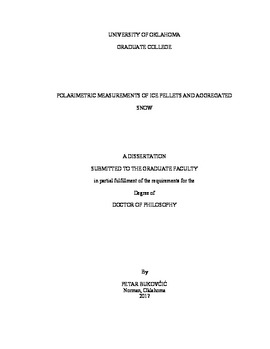| dc.description.abstract | The recent upgrade of the National Weather Service WSR-88D radar network to polarimetric capabilities provides the abundance of information about the precipitation microphysics. Even with the plethora of polarimetric measurements at our disposal, use of this essential information regarding the microphysical processes is underutilized. For example, there is no polarimetric relation for snow estimation. The focus of this study is to improve the existing state of polarimetric data usage for discrimination between the ice pellets and freezing rain if their occurrence is away from the radar (patchy, no radar-centric structure), and more importantly the development of the polarimetric relations for snow quantification.
Observations and analysis of an ice-liquid phase precipitation event, collected with an S-band polarimetric KOUN radar and a two-dimensional video disdrometer in central Oklahoma are presented. Using the disdrometer measurements, precipitation is classified either as ice pellets or rain/freezing rain. The ice pellets were challenging to detect by looking at conventional polarimetric radar data due to the localized and patchy nature of the ice phase and occurrence close to the ground. In this study, a new, unconventional way of looking at polarimetric radar data is introduced: Slanted Vertical Profiles SVPs at low (0° - 1°) radar elevations. From the analysis of the localized and patchy structures using SVPs, the polarimetric refreezing signature, reflected in local enhancement in ZDR and reduction in ZH and ρhv, became much more evident. Model simulations of sequential drop freezing using Marshal-Palmer DSDs along with the disdrometer observations suggest that preferential freezing of small drops may be responsible for the refreezing polarimetric signature.
Accurate measurements of snow amounts by radar are very difficult to achieve. The inherent uncertainty in radar snow estimates based on the radar reflectivity factor Z is caused by the variability of snow particle size distributions and snow particle density as well as large diversity of snow growth habits. In this study, a novel methodology for snow quantification based on the joint use of radar reflectivity Z and specific differential phase KDP is introduced. An extensive dataset of 2D video disdrometer measurements of aggregated snow in central Oklahoma is used to derive polarimetric relations for liquid-equivalent snowfall rate S and ice water content IWC in the forms of bivariate power-law relations. The physical basis of these relations is explained. Their multipliers are sensitive to variations in the width of the canting angle distribution, and to lesser extent particles’ aspect ratios and densities, whereas the exponents are practically invariant. This novel approach is tested against the S(Z) relation using snow disdrometer measurements in three geographical regions (Oklahoma, Colorado, and Canada). Similarly, the new approach is tested on polarimetric radar data at three localities, Oklahoma, Virginia, and Colorado. Polarimetric relations for snow quantification demonstrated significant improvement in snow estimates compared to the traditional Z-based methods. | en_US |
